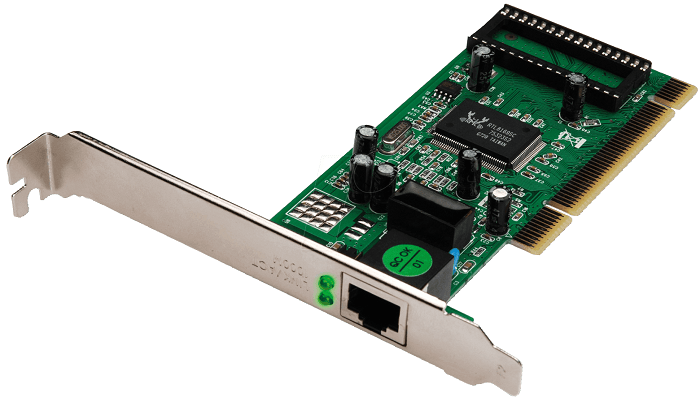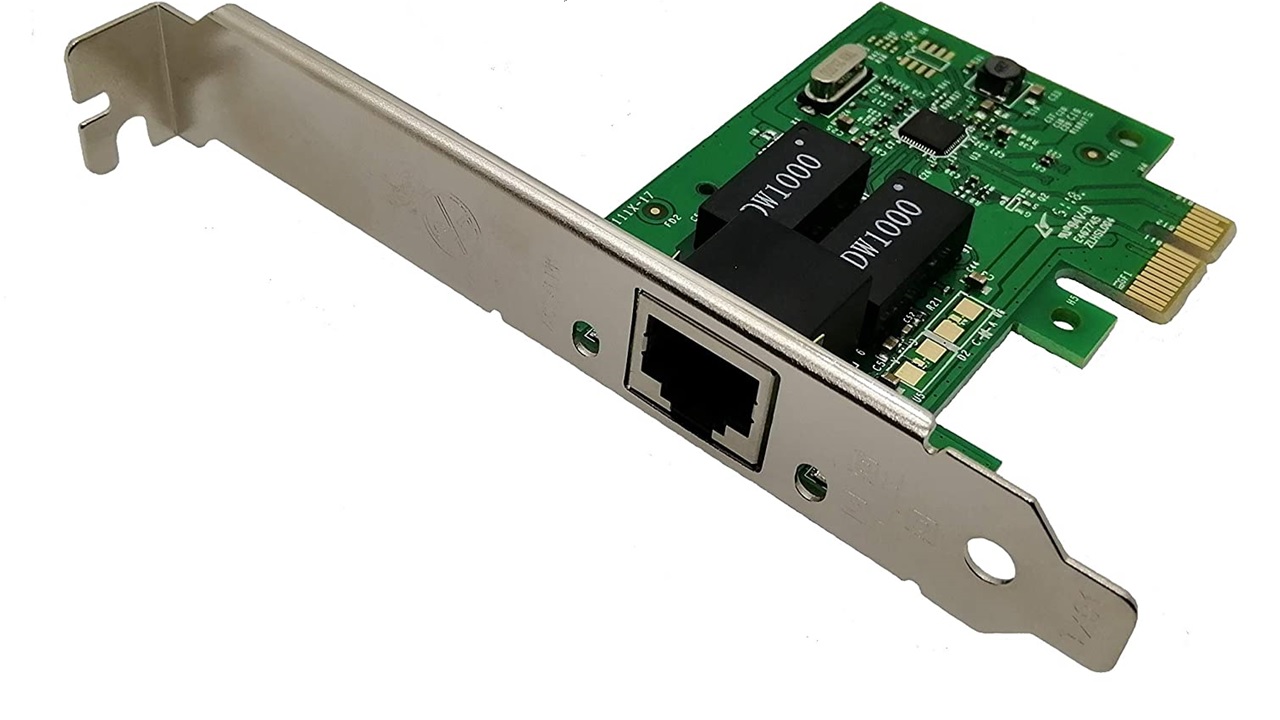In This Article
What is Network Interface Card (NIC)?
A Network Interface Card, which is also known by different names such as Ethernet card, Network Adaptor, or simply by its acronym NIC, is a hardware component that usually comes installed on the motherboard of a computer.
However, it may also come as a chip. These cards connect a lot of things and come in different types.
KEY TAKEAWAYS
- The Network Interface Card connected to the computer is the hardware that helps it to be connected to a network.
- There are different types of network cards available such as wired cards, port type cards, application based type, bus interface type, and those categorized on the basis of their transfer speed.
- These cards are reliable and offer faster access to the network though the need for hardwired connection which may affect the portability and security are some significant issues in it.
Understanding Network Interface Card (NIC)

A network interface card (NIC) is a hardware component that allows a computer to connect to a network.
It is also known as a network adapter, network interface controller, or Ethernet card.
Understanding NICs is important for anyone who wants to set up a network or troubleshoot network connectivity issues.
A NIC connects a computer to a network through a physical connection, such as an Ethernet cable or a wireless connection.
The NIC communicates with the network using a specific protocol, such as Ethernet, Wi-Fi, or Bluetooth.
NICs come in different types, including internal and external.
An internal NIC is built into a computer’s motherboard, while an external NIC is a separate component that connects to the computer through a USB port or a PCI slot.
Some NICs also come with additional features, such as support for multiple network protocols or advanced security features.
NICs can also have different speeds, which affect the amount of data that can be transferred over the network.
The speed of a NIC is usually measured in megabits per second (Mbps) or gigabits per second (Gbps).
One important factor to consider when choosing a NIC is compatibility with the computer and the network.
It is important to choose a NIC that is compatible with the computer’s operating system and the network’s protocols.
For example, if the network uses Ethernet, the NIC should support Ethernet.
In addition to compatibility, it is also important to consider the intended use of the NIC.
For example, if the network is used for gaming or video streaming, a NIC with a high speed and low latency is ideal.
NICs can also be a source of network connectivity issues. Common problems include incorrect configuration, outdated drivers, or hardware failure.
Troubleshooting network issues involving NICs may require advanced knowledge of computer hardware and networking protocols.
Types of Network Interface Card

There are many types of network interface cards. They are based on different features that are provided like the host interface application speed and many more. There are five categories found or five types of NIC in the computer.
- Network Connection Type
The network interface card is based on how the network connection is accessed. It comes in three and sometimes four types. The first connection type is wired NIC.
The input jacks in the wire and network interface cards are made of cables. These are used for network cards. That is inserted in the motherboard which has slots for it.
The next is the wireless network card which is inserted in the motherboard. But do not have any network cables. Which are connected to the internet and the computer.
They are not visible and are usually used for Wi-Fi connections. The next is the USB connection. The USB network connection provides the network to the computer through a device that is plugged in the USB port of the computer.
For example, the USB Ethernet adaptor is used for proper network connection on the computer. These are all connected with the help of the network card.
- Port Type
The second type is based on Port Type. The port type cable has four types of network interface card ports. Which are connected and are usually found in the market.
Like the RJ-45 port, BNC port, Optical port, USB port, and AUI port. The RJ-45 port is connected with cables which have twisted pairs.
The BNC port is a thin cable that is coaxial. The Optical port is used for transmission. And lastly, the AUI port is used for transmitter and receiver cable which is a thick coaxial cable.
- Bus Interface Type
The Bus Interface Type is a type where there are subcomponents. Like the network card, the PCI network card which has two variants and the USB network card.
The ISA or the Industry Standard Architecture network card was one of the first network cars which were manufactured. It contained a very low speed.
And because of the lower speed provided it has become obsolete in today’s world. The next is the PCI of the Peripheral Component Interconnect network card.
It was the successor of the ISA network card in the year 1990. These network cards were used in personal computers later before they were used in servers.
Many laptops these days do not have that many expansion cards. Because of the small size and the integrated motherboard has.
It’s successors to them comes the PCI-x or the Peripheral Component Interconnect Extended network card. It is a more advanced PCI network card.
Previously the PCI network card had operated 23 bit and 64 bit data. But the PCI-x has 64 bit and is also capable of 1064mb/s.
The PCI-x is sometimes compatible with the PCI network internet card also. Another type of the PC network card is the Peripheral Component Interconnect Express or the PCI-e network card.
Which is the latest and the most popular among servers, motherboards, and computers. The PCI-e network interface card is available in at least five versions now.
Having different speeds starting from 250 MB/s to 63.02 MB/s. The last network card is a USB Universal serial bus network card which is an external network card that has at least three versions and also works efficiently.
- Application Based Type
Then comes the network interface card which is based on the Application Based. The first one is the NIC found on the computer.
Most of the new computers which have a dedicated or inbuilt NIC to the motherboard. Therefore, a separate LAN is not needed which can reach up to 1 Gbps speed.
And allows one’s personal computer to communicate with other personal computer networks. And the next one is the server network card, it is used to manage or handle the network traffic. It requires a faster data transmission speed like 20G, 40G, and many more.
- Transmission Speed Type
And the last type is based on the transmission speed. The Transmission Speed has different types of speed that are provided starting from 100 Mbps, 225 G, or even higher than that.
These are available in the market and online. The network interface cards are adapted to 200 Mbps for small LAN. These are used at home and offices which are for regular use.
The NIC which is more than 1000 Mbps and higher provides a proper bandwidth used in large enterprises and data centers. Which also uses more than 1000 Mbps like 10 GB 25 GB and much more.
Network Interface Card Functions
- The network interface card is used to provide a network to the computer without which the computer will not be able to have any access to the internet.
- It is used as a middleman, it is because the network interface card passes the information to the server for the network.
- The network interface card can transmit and send signals to the different physical layers.
- The NIC even delivers data packets to all the physical layers.
- When a user opens a web page for a purpose like during browsing the web. Then the LAN helps to take the data given by the computer or the user to the internet server which is then displayed on the screen.
- The network interface card helps in the fast access of the internet used in many places like schools, houses, offices, and many more. The NIC is even used for enterprises that are used for in-depth tasks.
- Computers are connected to the network interface card over the internet. The data is traveled which is given to the network interface card. Then these are used in offices where individual login credentials are used.
- The network interface card lets the bulk data to be shared by many users.
Conclusion
After one has studied or understood the purpose, function, and have known almost everything about the network interface card.
Then, one should always keep in mind that many desktop computers use a wired connection.
The NIC along with many laptop computers are integrated. Therefore, it even comes with an integrated NIC which is wireless.
Therefore, one should always be well versed with the understanding and type of the network interface card one is purchasing. It is done to avoid problems in the future.